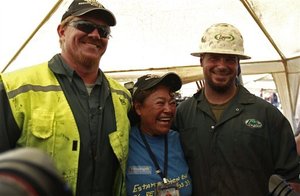
SAN JOSE MINE, Chile – Jeff Hart was drilling water wells for the U.S. Army’s forward operating bases in Afghanistan when he got the call to fly to Chile.
He spent the next 33 days on his feet, operating the drill that finally provided a way out Saturday for 33 trapped miners.
“You have to feel through your feet what the drill is doing; it’s a vibration you get so that you know what’s happening,” explained Hart, a contractor from Denver, Colorado.
A muscular, taciturn man with callused hands and a sunburned face, Hart normally pounds rock for oil or water.
He’s used to extreme conditions while he works the hydraulic levers that guide the drills’ hammers.
But this was something different – 33 lives were depending on him.
“I was nervous today,” said Hart, 40.
He joked that he thought it was his heart stopping when he felt an unexplained “pop” just before the drill broke through into a chamber far underground. “I didn’t want anything to go wrong.”
Within hours after the gold and copper mine collapsed Aug. 5, Chile’s government realized the mine’s owners were ill-equipped to handle the rescue and asked the state-owned Codelco mining company to take the lead.
Codelco turned to Geotec Boyles Bros., a U.S.-Chilean company, to handle the “Plan B” escape shaft, one of three simultaneous drilling efforts that raced to reach the miners.
Geotec operations manager James Stefanic said he quickly assembled “a top of the line team” of drillers who are intimately familiar with the key equipment, including engineers from two Pennsylvania companies – Schramm Inc., which makes the T130 drill, and Center Rock Inc., which makes the drill bits.
Hart was called in from Afghanistan, “simply because he’s the best” at drilling larger holes with the T130’s wide-diameter drill bits, Stefanic said.
Standing before the levers, pressure meters and gauges on the T130’s control panel, Hart and the rest of the team faced many challenges in drilling the shaft. At one point, the drill struck a metal support beam in the poorly mapped mine, shattering its hammers. Fresh equipment had to be flown in from the United States and progress was delayed for days as powerful magnets were lowered to pull out the pieces.
The mine’s veins of gold and copper ran through quartzite with a high level of abrasive silica, rock so tough that it took all their expertise to keep the drill’s hammers from curving off in unwanted directions. “It was horrible,” said Center Rock President Brandon Fisher, exhausted after hardly sleeping during the effort.
Fisher, Stefanic and Hart called it the most difficult hole they had ever drilled, because of the lives at stake.
“If you’re drilling for oil and you lose the hole, it’s different. This time there’s people down below,” Stefanic said.
“We ruined some bits, worked through the problems as a team, and broke through,” Hart said. “I’m very happy now.”
Miners’ relatives crowded around Hart on Saturday, hugging and posing for pictures with him as he walked down from the rescue operation into the tent camp where families had anxiously followed his work.
“He’s become the hero of the day,” said Dayana Olivares, whose friend Carlos Bugueno is one of the miners stuck below.
Champagne sprayed all around him after Hart guided the drill into the miners’ chamber. He pulled the last punch so that the drill extended just over two feet (65 centimeters) beyond the ceiling. A less experienced hand might have broken through with too much power, endangering the miners and even jamming the shaft with broken equipment.
“We got the job done,” Hart said simply.
Hart has a home in Denver but works for long periods abroad as a contractor for the Layne Christensen company based in Mission Woods, Kansas.
“We spend most of our time away from our families, but we don’t have the what-ifs they have down there,” he said of the miners. “Now they have an avenue to come out.”
Associated Press Writer Vivian Sequera contributed to this report.



















